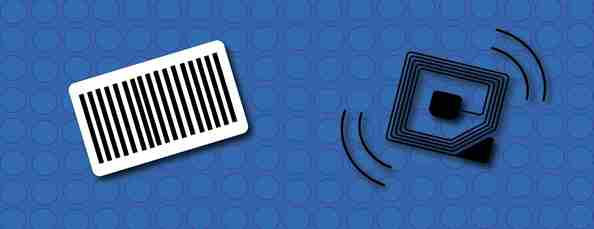Barcode vs. RFID Tag

In order to optimally manage the supply chain and production process, it is necessary to track the movement of each unit of goods, sometimes very detailed. Modern technologies make this task a lot easier.
Today, there are many methods of auto-identification, based on the principle of contactless reading of information.
The most popular and common of them are barcodes. However, it is rapidly catching up with radio frequency identification (RFID). This technology is successfully used by the world's largest retailers such as WalMart, Target and Tesco.
RFID is a generic term for technologies that are used to automatically identify radio wave objects. Radio waves are emitted by special tags placed on identifiable items. RFID allows you to track the location of items, boxes and pallets as they move through the supply chain to the consumer. Readers (RFID readers) collect information about each object into a central database.
There, code tags are identified with information about identifiable items, as a result of which the user of the system can at any time receive an exhaustive report on the relevant subject.
RFID technology provides higher speed and accuracy of information transfer in the supply chain than barcodes.
This difference is particularly noticeable in organizations with global supply chains and an extensive distribution and retail network.
More extensive RFID information collection capabilities ensure that there are no discrepancies in the data and greater transparency in the logistics scheme. This contributes to cost reduction and more efficient operation.
The goal of any retail store is to maximize customer satisfaction by maintaining optimal inventory levels while reducing operating costs. The key points of trading are receiving goods, reconciling and setting prices, moving goods into the sales area from the back room.
Successful trading can be hampered by the following problems:
• the goods have not entered the store
• the goods entered the store, but did not hit the storefront on time
• the goods are already on display, but it is not clear whether it can be sold
To avoid this, many retailers invest in technology solutions such as enterprise resource planning (ERP) or warehouse management systems (WMS). They are based on processing a large amount of data, therefore for their normal functioning, the reliable sources of information are needed. These sources are barcodes and RFID tags.
In retail, the advantages of RFID technology over barcodes are particularly pronounced. It allows you to quickly check the range of products and determine their prices, to avoid theft, to track the movement of store workers. Working with barcodes is more time consuming, since each of them must be read separately. In addition, they easily break down and become unreadable.
The warehouse is an important element in the supply chain. It works as a buffer, allowing businesses to respond more flexibly to demand spikes. Automatic identification systems help facilitate warehouse processes such as receiving, placing, picking and delivery of goods. In addition, they enable the improvement of a critical warehouse function, such as end-to-end storage. Placing RFID readers near the doors of the loading and unloading platform allows you to identify all product positions, instantly read the tags that are on the pallets and boxes, and determine from them where they need to be moved.
Production is the most important link in the logistics chain. Its key points are resource allocation, production planning, execution of the plan, data collection, quality control, and product life cycle management.
Auto-identification technologies are applicable at almost all stages of the production process from the primary processing of raw materials to the quality control of the finished product. The benefits of implementing RFID in manufacturing are numerous. Firstly, all that was said above about the warehouse is true. Secondly, this technology allows to simplify some processes, characteristic only for production.
The first is product lifecycle management. An RFID tag is mounted on the product or part that contains all the information about it's carrier, including the production date, the name of the manufacturer and the customer. This information remains readable by RFID readers for as long as necessary. This simplifies the management of product recall and warranty obligations. The second component of the production process that can be simplified is quality control. RFID tags work on entry and exit, ensuring that the right product goes to the right destination.
Finally, the use of RFID technology facilitates inventory management. This is one of the most serious arguments for RFID systems.
Cooperation of retailers, distributors and manufacturers in the field of collecting and sharing information will ensure the transparency of the supply chain to the level of a single object. Since RFID tags can be read in conditions where bar-coding systems are not applicable (high temperature, dirt, aggressive environment), and the information on the tags can be easily overwritten, RFID is ideal for inventory management.
Although RFID technology is capable of performing most of the functions of bar coding and some additional, it cannot yet become the dominant technology of auto-identification. Its use is much more expensive than using a barcode. Until the cost of RFID marking drops to at least 1 cent, bar coding is indispensable. Therefore, barcodes and RFID for many years will coexist in the same retail store.

